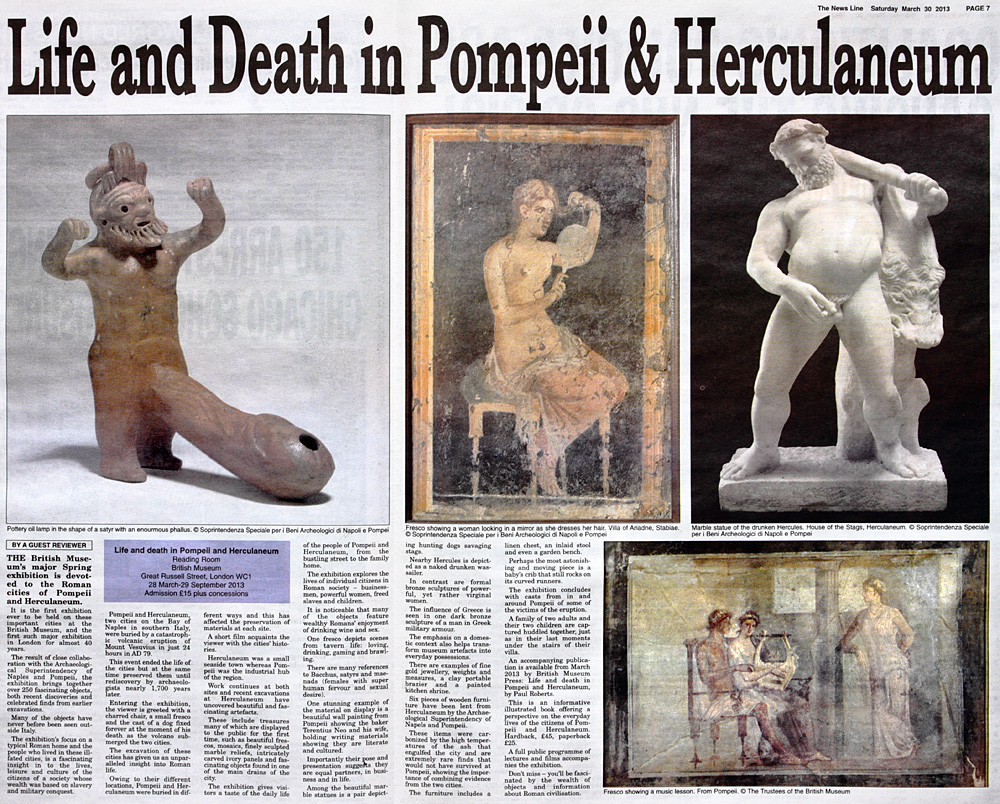 |
| The News Line Saturday March 30
2013 PAGE 7 Life and Death in Pompeii & Herculaneum BY A GUEST REVIEWER Life and death in Pompeii and Herculaneum Reading Room British Museum Great Russell Street, London WC1 28 March-29 September 2013 Admission £15 plus concessions THE British Museum's major Spring exhibition is devoted to the Roman cities of Pompeii and Herculaneum. It is the first exhibition ever to be held on these important cities at the British Museum, and the first such major exhibition in London for almost 40 years. The result of close collaboration with the Archaeological Superintendency of Naples and Pompeii, the exhibition brings together over 250 fascinating objects, both recent discoveries and celebrated finds from earlier excavations. Many of the objects have never before been seen outside Italy. The exhibition's focus on a typical Roman home and the people who lived in these ill-fated cities, is a fascinating insight in to the lives, leisure and culture of the citizens of a society whose wealth was based on slavery and military conquest. Pompeii and Herculaneum, two cities on the Bay of Naples in southern Italy, were buried by a catastrophic volcanic eruption of Mount Vesuvius in just 24 hours in AD 79. This event ended the life of the cities but at the same time preserved them until rediscovery by archaeologists nearly 1,700 years later. Entering the exhibition, the viewer is greeted with a charred chair, a small fresco and the cast of a dog fixed forever at the moment of his death as the volcano submerged the two cities. The excavation of these cities has given us an unparalleled insight into Roman life. Owing to their different locations, Pompeii and Herculaneum were buried in different ways and this has affected the preservation of materials at each site. A short film acquaints the viewer with the cities' histories. Herculaneum was a small seaside town whereas Pompeii was the industrial hub of the region. Work continues at both sites and recent excavations at Herculaneum have uncovered beautiful and fascinating artefacts. These include treasures many of which are displayed to the public for the first time, such as beautiful frescos, mosaics, finely sculpted marble reliefs, intricately carved ivory panels and fascinating objects found in one of the main drains of the city. The exhibition gives visitors a taste of the daily life of the people of Pompeii and Herculaneum, from the bustling street to the family home. The exhibition explores the lives of individual citizens in Roman society - businessmen, powerful women, freed slaves and children. It is noticeable that many of the objects feature wealthy Romans' enjoyment of drinking wine and sex. One fresco depicts scenes from tavern life: loving, drinking, gaming and brawling. There are many references to Bacchus, satyrs and maenads (females with super human fervour and sexual desire). One stunning example of the material on display is a beautiful wall painting from Pompeii showing the baker Terentius Neo and his wife, holding writing materials showing they are literate and cultured. Importantly their pose and presentation suggest they are equal partners, in business and in life. Among the beautiful marble statues is a pair depicting hunting dogs savaging stags. Nearby Hercules is depicted as a naked drunken wassailer. In contrast are formal bronze sculptures of powerful, yet rather virginal women. The influence of Greece is seen in one dark bronze sculpture of a man in Greek military armour. The emphasis on a domestic context also helps transform museum artefacts into everyday possessions. There are examples of fine gold jewellery, weights and measures, a clay portable brazier and a painted kitchen shrine. Six pieces of wooden furniture have been lent from Herculaneum by the Archaeological Superintendency of Naples and Pompeii. These items were carbonized by the high temperatures of the ash that engulfed the city and are extremely rare finds that would not have survived at Pompeii, showing the importance of combining evidence from the two cities. The furniture includes a linen chest, an inlaid stool and even a garden bench. Perhaps the most astonishing and moving piece is a baby's crib that still rocks on its curved runners. The exhibition concludes with casts from in and around Pompeii of some of the victims of the eruption. A family of two adults and their two children are captured huddled together, just as in their last moments under the stairs of their villa. An accompanying publication is available from March 2013 by British Museum Press: Life and death in Pompeii and Herculaneum, by Paul Roberts. This is an informative illustrated book offering a perspective on the everyday lives of the citizens of Pompeii and Herculaneum. Hardback, £45, paperback £25. A full public programme of lectures and films accompanies the exhibition. Don't miss - you'll be fascinated by the wealth of objects and information about Roman civilisation. http://www.wrp.org.uk |